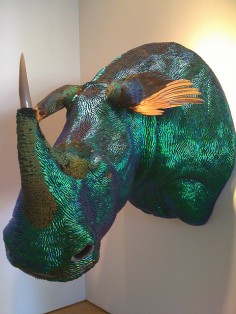Jan Fabre
Ян Фабр
얀 파브르
ヤン・ファーブル
Rhinoceros
source: janfabrebe
Jan Fabre (Antwerp, °1958) is a graduate of the Municipal Institute of Decorative Arts and the Royal Academy of Fine Arts. He is well known both at home and abroad as one of the most innovative and versatile artists of his day. Over the past 30 years, he has produced works as a visual artist, theatre maker and author. Jan
Jan Fabre (Antwerp, °1958) is a graduate of the Municipal Institute of Decorative Arts and the Royal Academy of Fine Arts. He is well known both at home and abroad as one of the most innovative and versatile artists of his day. Over the past 30 years, he has produced works as a visual artist, theatre maker and author. Jan Fabre is renowned for expanding the horizons of every genre to which he applies his artistic vision.
Angelos
Jan Fabre’s work in the visual arts is coordinated by Angelos. It covers all the projects, from museum and gallery exhibitions, public and private commissions, to the publishing of catalogues and special editions.
Jan Fabre (Antwerp, °1958) is a graduate of the Municipal Institute of Decorative Arts and the Royal Academy of Fine Arts. He is well known both at home and abroad as one of the most innovative and versatile artists of his day. Over the past 30 years, he has produced works as a visual artist, theatre maker and author. Jan Fabre is renowned for expanding the horizons of every genre to which he applies his artistic vision.
Angelos
Jan Fabre’s work in the visual arts is coordinated by Angelos. It covers all the projects, from museum and gallery exhibitions, public and private commissions, to the publishing of catalogues and special editions.
Troubleyn
Troubleyn/Jan Fabre is a theatre company with extensive international operations. The artist Jan Fabre has been its artistic head since it was established in 1986.
.
.
.
.
.
.
.
source: sculptureorg
Jan Fabre lives and works in his native Antwerp. Contemporary art aficionados know him for his powerful figurative or abstract drawings executed in blue ballpoint and his sculptures fraught with surface ornament. Fabre’s early drawings and sculptures of the 1970s reveal his abiding interest in performance art. The drawings often explored themes or motifs for a range of performance pieces, and the sculptures frequently arose out of live acts involving the body. Fabre’s works, which treat the weighty subjects of life, memory, and death by indirection, often come across as great feats of physical endurance.
The drawings, consisting of dense, monochrome fields of all-over hatching marks, eventually grew in scale. They were displayed either freestanding, with their rectos and versos exposed to view like pieces of sculpture, or glued onto forms ranging from bathtubs and sheds to the vast Castle Tivoli at Mechelen (1990), near Antwerp. The copper thumbtacks that Fabre employed in the early sculptures to encase representations of his body, as well as accompanying objects, eventually made way for (usually green) iridescent jewel beetles. The latter were affixed to invisible armatures of wire-mesh, suggesting three-dimensional things such as a urinal, a microscope, a Latin cross, a dress, and a hooded mantle. Today, the artist encloses voids with thin slices of human bone mounted on wire-mesh supports.
Fabre’s interest in performance art is reflected in his manifold activities as actor, author, choreographer, and film and theater director. This Belgian artist with seemingly inexhaustible energy is also the co-founder, publisher, and co-editor of Janus, a quarterly magazine on art and culture. Fabre has had over 50 one-person shows since 1984 and has taken part in numerous group exhibitions including the Venice Biennale (1984 and 1997), the Bienal de São Paulo (1991), Documenta IX (1992), and the Istanbul Biennale (1992 and 2001). This interview took place late one night at a terrace on the main civic square of Bruges, following a rehearsal of Fabre’s new theater production Parrots and Guinea Pigs (2002).


